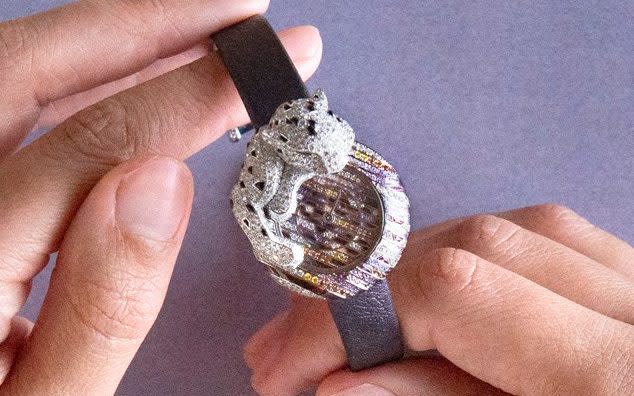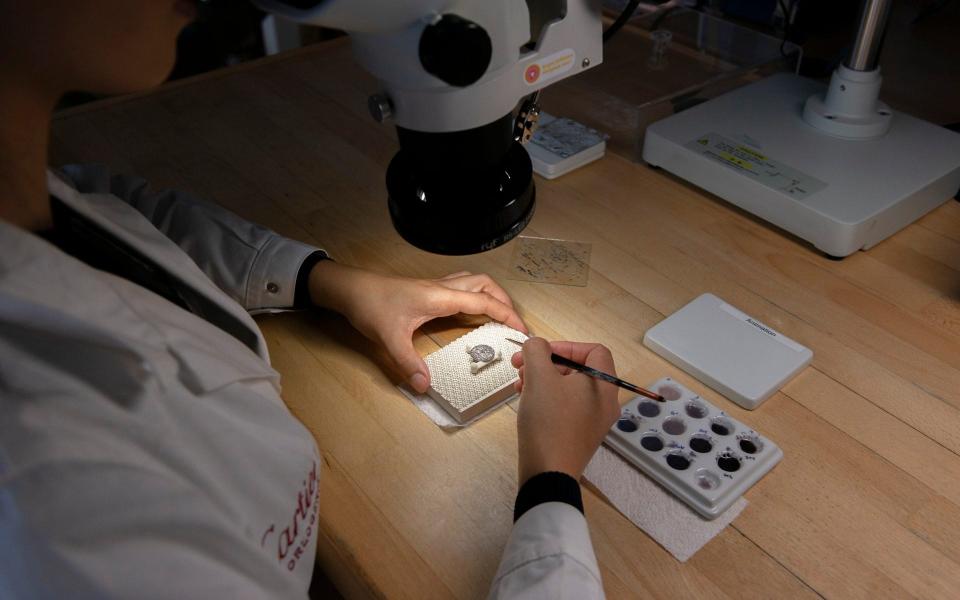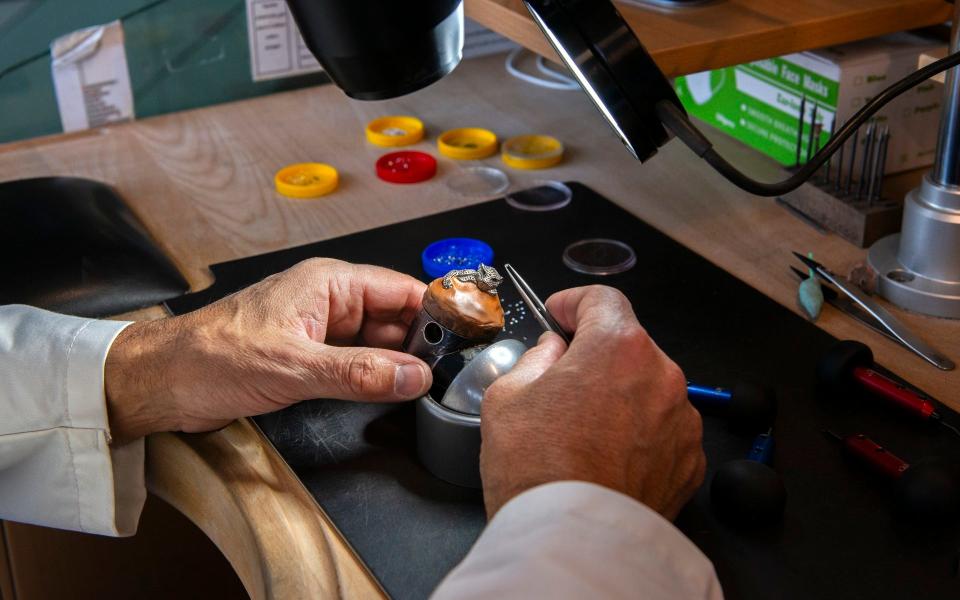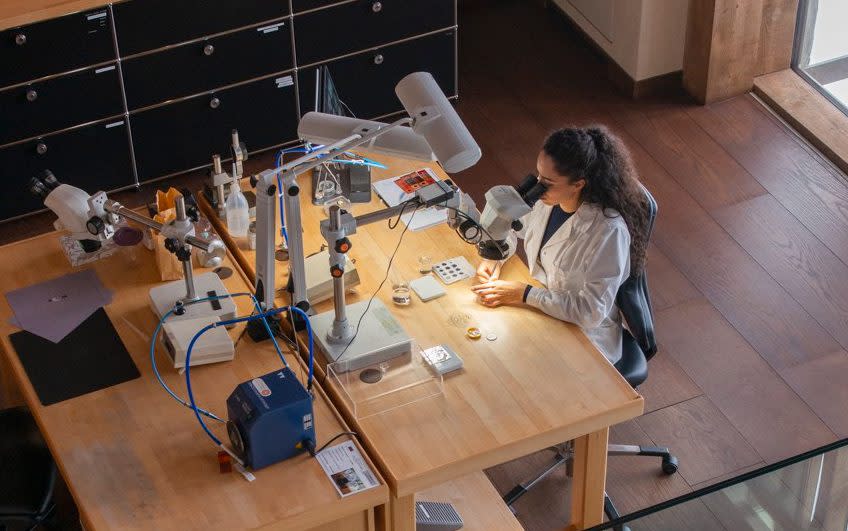Inside the Cartier watch laboratory hidden in a Swiss farmhouse

In the heart of La Chaux-de-Fonds in Switzerland’s ‘Watch Valley’, a few kilometres from the French border, is an unassuming 18th-century farmhouse – not dissimilar on the outside to dozens of others nearby. In this little Swiss home, it can feel as though time has stopped altogether, which is ironic because within its walls is Cartier’s Maison des Métiers d’Art (house of crafts), a laboratory like no other, dedicated to the art of time.
Beavering away within the farmstead, an array of craftspeople specialising in enamelling, engraving, stone setting and micro-marquetry are tasked with preserving traditional artisanal skills. But beyond this, Cartier seeks to resurrect and reappropriate lost techniques such as feather and rose-petal marquetry, and grisaille gold paste enamelling – a decorative technique believed to have been developed by Benedictine monks.

‘We have a lot of different workshops in the Maison,’ explains Karim Drici, Cartier’s manufacturing director. ‘Our teams have developed 16 crafts, and each is a field of adventure, as every métier is unique and has its own challenges.’ It’s not all in-house – Cartier also harnesses the talents of independent artists specialising in any technique its own staff have yet to master.
All this is close to the heart of the business, but nothing says Cartier like the panther does. The big cat first appeared on a Cartier watch bracelet in 1914; in the late 1940s the Duchess of Windsor wore two Cartier brooches featuring the sleek beast atop an enormous emerald and a sapphire, while socialite Daisy Fellowes snapped up the Toison d’Or panther brooch in the same decade.
In the 1950s the Aga Khan bought a panther bracelet, and in 1967 the Mexican star María Félix joined the cat club with a brooch and bracelet adorned with two panther heads. No wonder Jean Cocteau coined the word ‘panthéromanie’ to describe the feline fever that swept through society in the mid-20th century.

Like the jungle predator itself, Cartier’s panther is constantly on the move. In some designs it is geometric and graphic, in others sinewy and naturalistic. According to Pierre Rainero, Cartier’s director of image, style and heritage, the panther ‘appeared in the mid-1940s as the emblem of the new freedom that women could enjoy at that time. That is why it is not a question only of design, but of symbolism. Cartier was perceived as very daring at that time. The Maison became itself a symbol of free women.’
As Cartier’s first big cat adorned a watch, it is only fitting that the newest sighting is on the Panthère Songeuse (pensive panther) Métiers d’Art watch, a fusion of jewel and timekeeper that presents a philosophical feline – deep in thought (or half asleep, your choice), its body draped over the side of the case, eyes half closed.
The original 2021 Panthère Songeuse was Cartier’s first fine-jewellery watch to bring together sculpture and enamelling – a combination now repeated for 2024. The panther is sculpted in white gold (also used for the case and base dial) and encrusted with a total of 2.68 carats of white diamonds, her features highlighted by 0.5 carats of pear-shaped emeralds for the eyes and a cabochon onyx nose. Her black spots are of hand-set onyx.

This year’s version further demonstrates the Maison’s dedication to colour, placing the animal against a radiant sunset backdrop of an array of purple enamels complemented by yellow and orange garnets and diamonds. The calfskin strap is tanned in a process that includes iridescent pigments to achieve the effect of light radiating out from inside the leather, reflecting the enamel and stone colours.
Five gradated shades of amethyst and mulberry enamel are crushed by hand in a five-hour process and then layered on to a silver-leaf base, an ancient technique that comes under the umbrella term of paillonné. Cartier has adapted the process to make it practical for watchmaking and added a twist by ‘crumpling’ the foil with tweezers to give a greater relief effect.
In a marriage of tradition and technology, craftsmen first roll and hammer the foil to between two and 10 microns thick (for comparison, a human hair is approximately 70 microns) before it is laser cut to precisely fit the ‘pockets’ in which it is placed on the dial. The resulting finish gives specific volume and reflection to the enamel.
After the enamel has been fired six times over the course of 36 hours at 700-800C, 673 brilliant-cut white diamonds, 12 brilliant-cut yellow diamonds, 26 spessartite garnets and six buff-top rhodolite garnets are individually set into the case and dial to highlight the purple hues. This is all carried out within the codes of the Responsible Jewellery Council and the Maison’s Watch & Jewellery Initiative 2030, which was established in 2022 to build climate resilience, preserve resources and foster inclusivity.

‘We always approach watchmaking through the eyes of a jeweller,’ says Drici. ‘We don’t see a case with a dial, but rather a complete object where the case and dial merge.’ That said, these miniature artworks have a purpose – to tell the time accurately – and the additional space that a stone-set dial needs can potentially cause issues with the free movement of the hands.
With proportions and thinness being priorities for Cartier, there is just 0.15mm free space between the dial and the hour hand, and on a Métiers d’Art dial, this means that many of the watchmaking processes have to be executed manually, requiring close cooperation between designers, watchmakers and setters. The quartz movement also needs to be protected from all the stresses of everyday living, and the watch is tested for water resistance to 30 metres.
According to Drici, the biggest challenge in any of these intricate timepieces is the combination of the different métiers. Putting this into context, each Panthère Songeuse requires approximately 500 hours to make – 36 for enamelling, 180 for jewellery, 261 for stone setting, and 10 for polishing – with a lead time of two to three months. Only 12 will be created, making them extremely rare. A craftsman can work for 42 years at Cartier and only ever produce 36 objects.
‘These are very precious watches that require a specific mindset. And in the Maison des Métiers d’Art we want to protect this,’ says Drici.


